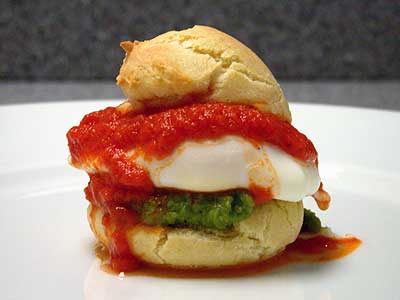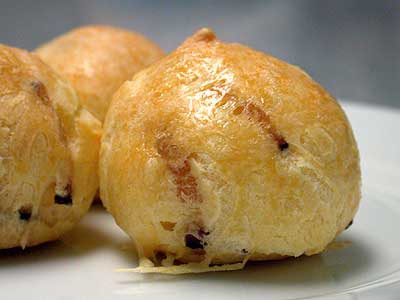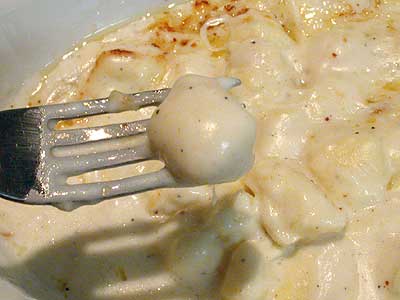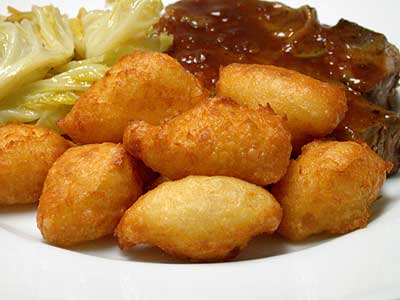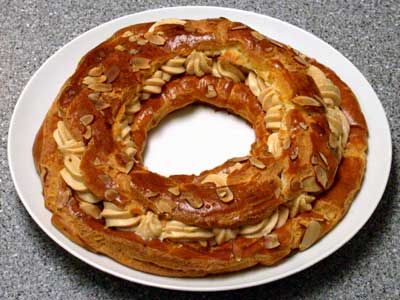

When it comes to pastry doughs, pâte à choux sits off in a class by itself. Whereas other doughs can be formed into various shapes, pâte à choux is so soft that it hardly supports itself before baking. Before baking, pâte à choux must either be spooned or piped into shape. Plus, pâte à choux contains eggs, in addition to flour and fat, which give the dough the ability to rise dramatically when baked. (And often collapse when cooled!)
Pâte à choux has been around for quite a while. According to Claude Juillet in Classic Patisserie: An A-Z Handbook,
In 1533, when Catherine de Medici left Florence to marry the Duke of Orleans who was later to become Henry II, King of France from 1547, she brought with her to France her entire court, which included her chefs. Seven years later in 1540, her head chef, Panterelli, invented a hot, dried paste with which he made gateaux. He christened the paste pâte à Panterelli.
The original recipe changed as the years passed, and so did the paste’s name. It became known as pâte à Popelini, which then became pâte à Popelin. Popelins were a form of cake made in the Middle Ages and were made in the shape of a woman’s breasts. A patissier called Avice perfected the paste in the middle of the eighteenth century and created choux buns. The pâte à Popelin became known as pâte à choux, since only choux buns were made from it. [And choux buns were the same shape as small cabbages. Choux is the French word for cabbages.] Antoine Carême in the nineteenth century perfected the recipe, and this is the same recipe for choux pastry as is used today.
Classic French cuisine from the mid-1950s is resplendent with dishes made from pâte à choux. Today, other than éclairs at one’s local patisserie, gougères served as an amouse-bouche in Burgundy, and croquembouches, stacks of profiteroles glued together with caramel, served for celebrations, many of the classic dishes based on pâte à choux are seldom found.
Whether used in sweet or savory dishes, the pâte à choux is prepared the same way, as explained below.


Cooking the pâte à choux — whether by baking, boiling, or frying — is performed as specified in individual recipes. The larger the piece of pâte à choux being cooked, the more critical the process becomes. Larger pieces need to be cooked longer to obtain a good rise from the dough and cooled slower to prevent collapsing.
In its simplest form, pâte à choux can just be formed into small balls with a couple of spoons and deep-fried as fritters as in beignets soufflés. When baked, the small balls become profiteroles, which can be filled with a myriad of sweet or savory items. Or cut the profiteroles open, and use them as pastry shells as in œufs pochés Bodin. Or the pâte à choux used can be flavored with cheese to make gougères, sometimes called chouquettes. Add a little bacon and voilà — gougères au lard. If the pâte à choux is boiled and served with a sauce you have gnocchi à la parisienne. If the pâte à choux is mixed with some potato puree and fried, the result is the classic garnish pommes dauphine. Baked into rectangular shapes and filled with pastry cream, pâte à choux becomes classic éclairs. Baked into round shapes, filled with pastry cream, and stacked, it becomes religieuse. But baked in a ring shape and filled with praline-flavored pastry cream, pâte à choux becomes the famous desert Paris-Brest.
Although the process of preparing dishes with pâte à choux may initially appear daunting, it is often much simpler than preparing dishes with other forms of pastry. Plus, items made with pâte à choux are more fun to eat!
©2003, 2014 Peter Hertzmann. All rights reserved.




